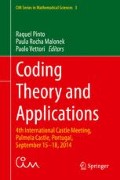Abstract
In this paper we consider a special class of 2D convolutional codes (composition codes) with encoders G(d 1, d 2) that can be decomposed as the product of two 1D encoders, i.e., \(G(d_{1},d_{2}) = G_{2}(d_{2})G_{1}(d_{1})\). In case that \(G_{1}(d_{1})\) and \(G_{2}(d_{2})\) are prime we provide constructions of syndrome formers of the code, directly from \(G_{1}(d_{1})\) and \(G_{2}(d_{2})\). Moreover we investigate the minimality of 2D state-space realization by means of a separable Roesser model of syndrome formers of composition codes, where \(G_{2}(d_{2})\) is a quasi-systematic encoder.
Access this chapter
Tax calculation will be finalised at checkout
Purchases are for personal use only
Notes
- 1.
A polynomial matrix G(d 1, d 2) is right/left-zero prime (rZP/lZP) if the ideal generated by the maximal order minors of G(d 1, d 2) is the ring \(\mathbb{F}[d_{1},d_{2}]\) itself, or equivalently if and only if admits a polynomial left/right inverse. Moreover right/left-zero primeness implies right/left-factor primeness(rFP/lFP).
- 2.
A minimal 1D encoder is an encoder with minimal McMillan degree among all the encoders of the same code.
- 3.
A full row (column) rank matrix \(M(d) \in \mathbb{F}^{n\times k}[d]\) is said to be row (column) reduced if \(\mathrm{int}\deg M(d)\) is equal to the sum of the row (column) degrees of M(d); in that case \(\mu (M) =\mathrm{ int}\deg M(d)\).
References
Attasi, S.: Systèmes linèaires homogènes á deux indices. Technical report, Rapport Laboria (1973)
Fornasini, E., Marchesini, G.: Algebraic realization theory of two-dimensional filters. In: Ruberti, A., Mohler, R. (eds.) Variable Structure Systems with Application to Economics and Biology. Lecture Notes in Economics and Mathematical Systems, vol. 111, pp. 64–82. Springer-Verlag, Berlin-Heidelberg-New York (1975)
Fornasini, E., Pinto, R.: Matrix fraction descriptions in convolutional coding. Linear Algebra Appl. 392, 119–158 (2004)
Fornasini, E., Valcher, M.E.: Algebraic aspects of two-dimensional convolutional codes. IEEE Trans. Inf. Theory 40(4), 1068–1082 (1994)
Forney, G.: Convolutional codes I: algebraic structure. IEEE Trans. Inf. Theory 16(6), 720–738 (1970)
Forney, G.: Structural analysis of convolutional codes via dual codes. IEEE Trans. Inf. Theory 19, 512–518 (1973)
Lévy, B.: 2D polynomial and rational matrices, and their applications for the modeling of 2-D dynamical systems. Ph.d. dissertation, Stanford University, Stanford (1981)
Lin, T., Kawamata, M., Higuchi, T.: Decomposition of 2-D separable-denominator systems: existence, uniqueness, and applications. IEEE Trans. Circuits Syst. 34(3), 292–296 (1987)
Pinho, T.: Minimal state-space realizations of 2D convolutional codes. Phd dissertation, Department of Mathematics, University of Aveiro (2014)
Pinho, T., Pinto, R., Rocha, P.: Minimal realizations of a special case of 2D codes. In: Proceedings of the MTNS, Groningen (2014)
Pinho, T., Pinto, R., Rocha, P.: Realization of 2D convolutional codes of rate \(\frac{1} {n}\) by separable roesser models. Des. Codes Cryptogr. 70, 241–250 (2014)
Rocha, P., Willems, J.C.: Controllability of 2-D systems. IEEE Trans. Autom. Control 36(4), 413–423 (1991)
Roesser, R.P.: A discrete state-space model for linear image processing. IEEE Trans. Autom. Control 20(1), 1–10 (1975)
Acknowledgements
This work was supported by Portuguese funds through the CIDMA – Center for Research and Development in Mathematics and Applications, and the Portuguese Foundation for Science and Technology (“FCT-Fundac̣ão para a Ciência e a Tecnologia”), within project UID/MAT/04106/2013.
Author information
Authors and Affiliations
Corresponding author
Editor information
Editors and Affiliations
Rights and permissions
Copyright information
© 2015 Springer International Publishing Switzerland
About this paper
Cite this paper
Fornasini, E., Pinho, T., Pinto, R., Rocha, P. (2015). Minimal Realizations of Syndrome Formers of a Special Class of 2D Codes. In: Pinto, R., Rocha Malonek, P., Vettori, P. (eds) Coding Theory and Applications. CIM Series in Mathematical Sciences, vol 3. Springer, Cham. https://doi.org/10.1007/978-3-319-17296-5_19
Download citation
DOI: https://doi.org/10.1007/978-3-319-17296-5_19
Publisher Name: Springer, Cham
Print ISBN: 978-3-319-17295-8
Online ISBN: 978-3-319-17296-5
eBook Packages: Mathematics and StatisticsMathematics and Statistics (R0)

